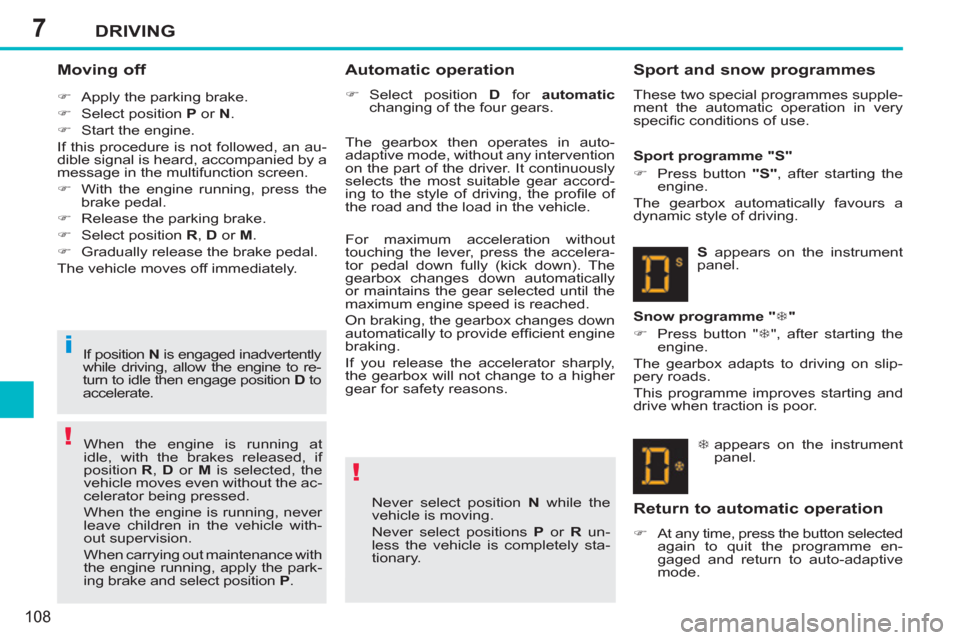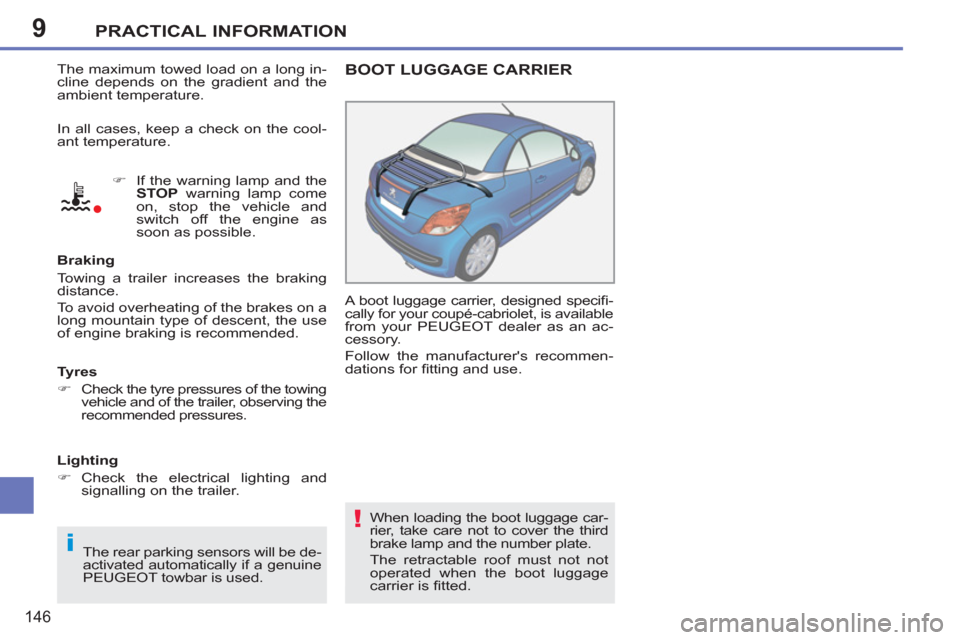2011.5 Peugeot 207 CC brakes
[x] Cancel search: brakesPage 29 of 224

1INSTRUMENTS and CONTROLS
Warning lamp
is on
Cause
Action/Observations
Airbags
temporarily. This lamp comes on for a
few seconds when you turn
on the ignition, then goes
off. This lamp should go off when the engine is
started.
If it does not go off, contact a PEUGEOT dealer
or a qualifi ed workshop.
fi xed. One of the airbag or seat
belt pretensioner systems
has a fault. Have it checked by a PEUGEOT dealer or a
qualifi ed workshop.
Seat belt not
fastened/
unfastened
fi xed then
fl ashing
accompanied
by an
increasing
audible signal. The driver and/or the front
passenger has not fastened
or has unfastened their seat
belt. Pull the strap then insert the tongue in the
buckle.
Power
steering
fi xed. The power steering has a
fault. Drive carefully at reduced speed.
Have it checked by a PEUGEOT dealer or a
qualifi ed workshop.
Water in
Diesel
fi xed. The Diesel fuel fi lter
contains water. Risk of damage to the injection system on Diesel
engines.
Contact a PEUGEOT dealer or a qualifi ed
workshop without delay.
Directional
headlamps
fl ashing. The directional headlamps
system has a fault. Have it checked by a PEUGEOT dealer or a
qualifi ed workshop.
Punctured
wheel
fi xed. One or more wheels are
punctured or seriously
defl ated. Stop immediately avoiding any sharp action on
the steering wheel or the brakes.
Repair or change the damaged wheel and have
the pressure of the tyres checked as soon as
possible.
Page 97 of 224

6
!
i
i
i
SAFETY
95
TYRE UNDER-INFLATION
DETECTION
System which automatically checks the
pressure of the tyres while driving.
All repairs and changing of tyres on
a wheel fi tted with this system must
be carried out by a PEUGEOT
dealer or a qualifi ed workshop.
If, when changing a tyre, you in-
stall a wheel which is not detected
by your vehicle (example: fi tting
of snow tyres), you must have the
system reinitialised by a PEUGEOT
dealer or a qualifi ed workshop.
This system does not eliminate
the need to have the tyre pres-
sure checked regularly (refer to
the "Technical information - Identi-
fi cation markings" page) to ensure
that the optimum dynamic perform-
ance of the vehicle is maintained
and prevent premature wear of the
tyres, particularly in arduous driv-
ing conditions (heavy load, high
speed).
The tyre pressures must be checked
cold, at least once a month. Re-
member to check the pressure of
the spare wheel.
The tyre under-infl ation detection
system may experience temporary
interference due to electro-magnetic
signals on a frequency close to that
used by the system.
Sensors fi tted in each valve trigger a
warning in the event of malfunction. The
speed has to be above 12 mph (20 km/h).
Flat tyre
A message appears in the multifunction
screen, accompanied by an audible signal,
to locate the wheel concerned.
�)
Check the tyre pressures as soon
as possible.
This check must be carried out when
the tyres are cold. This warning lamp and the STOP
warning lamp come on in the in-
strument panel, accompanied by
an audible signal and a message
in the multifunction screen locating
the wheel concerned.
�)
Stop immediately, avoiding any sud-
den movement of the steering wheel
and the brakes.
�)
Change the damaged wheel (punc-
tured or very defl ated tyre), and
have the tyre pressure checked as
soon as possible.
Puncture
The tyre under-infl ation detection
system is an aid to driving which does
not replace the need for the driver to
be vigilant or to drive responsibly.
Sensor(s) not detected or faulty
A message appears in the multifunction
screen, accompanied by an audible sig-
nal, to locate the wheel or wheels which
are not detected or to indicate a fault in
the system.
Contact a PEUGEOT dealer or a quali-
fi ed workshop to replace the faulty
sensor(s).
This message is also displayed
when one of the wheels is away
from the vehicle (being repaired) or
when one or more wheels without a
sensor are fi tted.
The spare wheel is not fi tted with
a sensor.
Page 99 of 224

6
!
SAFETY
97
The ESP/ASR systems offer ex-
ceptional safety in normal driving,
but this should not encourage the
driver to take extra risks or drive at
high speed.
The correct functioning of these
systems depends on observation
of the manufacturer's recommen-
dations regarding the wheels (tyres
and rims), the braking components,
the electronic components and the
PEUGEOT assembly and opera-
tion procedures.
After an impact, have these sys-
tems checked by a PEUGEOT
dealer.
Deactivation
In exceptional conditions (starting a ve-
hicle which is bogged down, stuck in
snow, on soft ground, ...), it may be ad-
visable to deactivate the ASR and ESP
systems, so that the wheels can move
freely and regain grip.
�)
Press the "ESP OFF"
button, located
in the centre of the dashboard.
If this warning lamp comes on on the in-
strument panel and the indicator lamp on
the button comes on, this indicates that the
ASR and ESP systems are deactivated.
Reactivation
These systems are reactivated automat-
ically each time the ignition is switched
back on or from 30 mph (50 km/h).
�)
Press the "ESP OFF"
button again
to reactivate them manually.
Operating fault
If this warning lamp comes on,
accompanied by an audible sig-
nal and a message on the multi-
function screen, this indicates a
malfunction of these systems.
Have them checked by a PEUGEOT dealer.
TRAJECTORY CONTROL
SYSTEMS
Activation
These systems are activated automati-
cally each time the vehicle is started.
Anti-slip regulation (ASR) and
electronic stability programme
(ESP)
They come into operation in
the event of a grip or trajectory
problem.
This is indicated by fl ashing of
this warning lamp in the instru-
ment panel.
The anti-slip regulation (also known as
Traction Control) optimises traction to
prevent skidding of the wheels, by act-
ing on the brakes of the driving wheels
and on the engine.
The electronic stability programme acts
on the brake of one or more wheels and
on the engine to keep the vehicle on the
trajectory required by the driver, within
the limits of the laws of physics.
Page 110 of 224

7
!
!
i
DRIVING
108
Moving off
�)
Apply the parking brake.
�)
Select position P
or N
.
�)
Start the engine.
If this procedure is not followed, an au-
dible signal is heard, accompanied by a
message in the multifunction screen.
�)
With the engine running, press the
brake pedal.
�)
Release the parking brake.
�)
Select position R
, D
or M
.
�)
Gradually release the brake pedal.
The vehicle moves off immediately.
If position N
is engaged inadvertently
while driving, allow the engine to re-
turn to idle then engage position D
to
accelerate. The gearbox then operates in auto-
adaptive mode, without any intervention
on the part of the driver. It continuously
selects the most suitable gear accord-
ing to the style of driving, the profi le of
the road and the load in the vehicle.
Automatic operation
�)
Select position D
for automatic
changing of the four gears.
�7
appears on the instrument
panel.
Snow programme " �7
"
�)
Press button " �7
", after starting the
engine.
The gearbox adapts to driving on slip-
pery roads.
This programme improves starting and
drive when traction is poor.
S
appears on the instrument
panel.
Sport programme "S"
�)
Press button "S"
, after starting the
engine.
The gearbox automatically favours a
dynamic style of driving.
Never select position N
while the
vehicle is moving.
Never select positions P
or R
un-
less the vehicle is completely sta-
tionary. When the engine is running at
idle, with the brakes released, if
position R
, D
or M
is selected, the
vehicle moves even without the ac-
celerator being pressed.
When the engine is running, never
leave children in the vehicle with-
out supervision.
When carrying out maintenance with
the engine running, apply the park-
ing brake and select position P
.
Sport and snow programmes
These two special programmes supple-
ment the automatic operation in very
specifi c conditions of use.
Return to automatic operation
�)
At any time, press the button selected
again to quit the programme en-
gaged and return to auto-adaptive
mode.
For maximum acceleration without
touching the lever, press the accelera-
tor pedal down fully (kick down). The
gearbox changes down automatically
or maintains the gear selected until the
maximum engine speed is reached.
On braking, the gearbox changes down
automatically to provide effi cient engine
braking.
If you release the accelerator sharply,
the gearbox will not change to a higher
gear for safety reasons.
Page 124 of 224

8
!
CHECKS
122
Only use products recommended
by PEUGEOT or products of equiv-
alent quality and specifi cations.
In order to optimise the operation
of units as important as the braking
system, PEUGEOT selects and of-
fers very specifi c products.
To avoid damaging the electrical
units, the use of a high pressure
washer in the engine compartment
is strictly prohibited
.
Automatic gearbox
The gearbox does not re-
quire any maintenance (no oil
change).
Refer to the servicing booklet
for details of the checking in-
tervals for this component.
Brake disc and drum wear
For any information relating
to checking of the brake disc
and/or drum wear, contact a
PEUGEOT dealer or a quali-
fi ed workshop.
Manual gearbox
The gearbox does not re-
quire any maintenance (no oil
change).
Refer to the servicing booklet
for details of the level checking
intervals for this component.
Brake pads
Brake wear depends on the
style of driving, particularly in
the case of vehicles used in
town, over short distances. It
may be necessary to have the
condition of the brakes checked, even
between vehicle services.
Unless there is a leak on the circuit, a
drop in the brake fl uid level indicates
that the brake pads are worn.
Parking brake
If the parking brake travel is
too long or if you notice a loss
of effectiveness of this sys-
tem, the parking brake must
be adjusted, even between
two services.
This system must be checked by a PEUGEOT
dealer or a qualifi ed workshop.
Page 148 of 224

9
i
!
PRACTICAL INFORMATION
146
The maximum towed load on a long in-
cline depends on the gradient and the
ambient temperature.
�)
If the warning lamp and the
STOP
warning lamp come
on, stop the vehicle and
switch off the engine as
soon as possible.
Braking
Towing a trailer increases the braking
distance.
To avoid overheating of the brakes on a
long mountain type of descent, the use
of engine braking is recommended.
Tyres
�)
Check the tyre pressures of the towing
vehicle and of the trailer, observing the
recommended pressures.
The rear parking sensors will be de-
activated automatically if a genuine
PEUGEOT towbar is used.
In all cases, keep a check on the cool-
ant temperature.
Lighting
�)
Check the electrical lighting and
signalling on the trailer. BOOT LUGGAGE CARRIER
A boot luggage carrier, designed specifi -
cally for your coupé-cabriolet, is available
from your PEUGEOT dealer as an ac-
cessory.
Follow the manufacturer's recommen-
dations for fi tting and use.
When loading the boot luggage car-
rier, take care not to cover the third
brake lamp and the number plate.
The retractable roof must not not
operated when the boot luggage
carrier is fi tted.